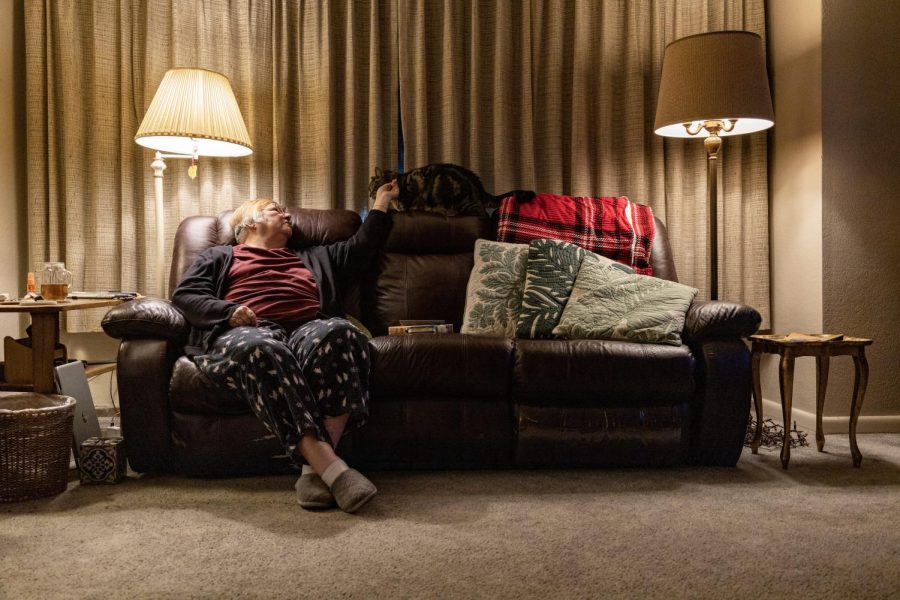- Beavers Digest
- Beavers Digest / Culture
- Beavers Digest / Culture / Community
- Beavers Digest / Culture / Expression
- Beavers Digest / Culture / People
Overcoming generations of stigma
Breaking down decades of stigmatization after the legalization of cannabis in 21 states
Ashton Bisner, OMN Photographer
Annie (prefers to keep last name out; she/her) sits on her living room sofa with Danny the cat on Nov. 19. Annie routinely smokes in this location to relax by reading and help alleviate pain. The normalization of weed, in Annie’s opinion, is great because accessibility of the substance is safer and more reliable to obtain for those who enjoy using it.
As it stands, cannabis is a federally illegal substance that the U.S. Drug Enforcement Association still lists as a schedule 1 drug, alongside heroin, LSD and MDMA. This states cannabis is a drug with high potential for abuse, has no accepted use for medical treatment and lacks safety to be used under medical supervision.
More than a century of harmful propaganda around the drug is starting to collapse with widespread cannabis legalization across the U.S., though more quickly in some generations than others.
Camden Schmidt, 21, is a senior environment economics and policy major at Oregon State University who grew up in Shiane, Wyoming. The main stereotypes he heard about the drug growing up arose from the 1936 film, “Reefer Madness,” which was part of a series of anti-cannabis films. These films typically displayed high schoolers trying cannabis products and then falling into dramatized experiences with accidental manslaughter, suicide, attempted sexual assault, hallucinations and madness.
“The narrative I understood was that if you smoke weed, you will become a lazy leach of society,” said Schmidt.
Annie, a local source, age 76, shared her experiences with cannabis and wanted to keep her last name anonymous. She said the drug was highly frowned upon when she was growing up in Kauai, Hawaii and was highly associated with hippy culture.

When Annie moved to Louisiana for school, she noticed a clear shift in social norms, racial
remarks and judgments around the drug.
At school in Wyoming, Schmidt explained that cannabis was equated to cocaine and meth; there was no separation between them. Weed was portrayed as an evil gateway drug that would lead you down dark paths, he said. Schmidt said this narrative around cannabis in his upbringing created an instant “villainization” of people who were portrayed as consuming cannabis in the media.
It wasn’t until Schmidt went to high school and was exposed to the cultural scene surrounding cannabis that his ideas around the substance began to change, especially once Colorado and other states in the U.S. began legalizing it.
“I realized if it’s becoming legalized, it can’t actually be that bad,” Schmidt said.
Annie said she had started using cannabis when she was younger and experienced shame from her community, especially before legalization. Since legalization, she said the people around her have grown more accepting.
In Wyoming, however, cannabis is still very much illegal.
“There were still people who smoked in high school, but drinking was much more the prominent culture,” Schmidt said. “Weed was still a part of the culture, but it was very taboo.”
Growing up, Schmidt’s parents made it clear that drinking was acceptable, almost expected, but the same was not true for weed. He said he understood that his parents grew up with the same villainizing rhetoric around cannabis. They were never exposed to any other information about weed until they were in their forties, when it started becoming legal—but by then these ideas were already deeply ingrained.
Annie said cannabis is not the gateway drug a lot of people believe it to be. For her, cannabis has been more medicinal than harmful. Today, she uses the substance mainly for pain and stress relief.
According to Johannah Hamilton, properties from hemp—a type of cannabis with less THC—can be a great natural alternative for pain and anxiety that is much better than opioids. Hamilton is the owner of Melanin Minerals, a Corvallis-based beauty shop that sells CBD-infused products, a chemical that comes from cannabis.
Coming to Oregon for college, Schmidt almost experienced a culture shock. He said the most surprising things about moving to Oregon was how freely people talked about cannabis, even to people who don’t smoke, and how much it is valued as an agricultural product.
“It was weird going from having hush-hush conversations with my friends to being given a scholarly article about weed agriculture,” Schmidt said.
Another thing Schmidt found surprising was the ratio of dispensaries to liquor stores. He said they were quite common in Wyoming, but in Corvallis there are only two liquor stores compared to the 20 dispensaries.
Hamilton said she had had a similar experience when moving states.
“When I came to Oregon from Alabama, it was a culture shock because you didn’t see CBD in the stores and gas stations back home, but in Oregon it was everywhere,” Hamilton said. “I was like wow, this is so normalized up here and not taboo.”
Schmidt pointed out that highlighting the diverse demographics of people who use cannabis, as well as researching health benefits, can help destigmatize the drug by shifting public perception.





